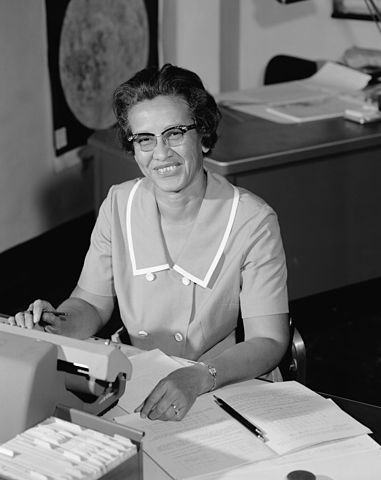Women In STEM: Part 4: Math

By NASA; restored by Adam Cuerden – http://www.nasa.gov/sites/default/files/thumbnails/image/1966-l-06717.jpeg, Public Domain, https://commons.wikimedia.org/w/index.php?curid=47431407
Math:
Katherine Johnson was born Katherine Coleman on August 26, 1918, in White Sulphur Springs, West Virginia, the youngest of four children. Her skill with mathematics and numbers manifested at a young age; by the time she was 10 years old she was taking classes at the high school on the campus of West Virginia State College. At 14, she enrolled at the college itself, and made short work of the school’s math syllabus, graduating 4 years later with bachelor’s degrees in both French and mathematics.
West Virginia began to integrate its graduate schools in 1939, beginning quietly with three African-American students: Katherine Johnson and two men. Johnson married her first husband, James Goble, later that year, and quit graduate school after her first session to start a family.
Johnson knew that she wanted to do something math-related with her career, so she settled on a job as a research mathematician. That was a bold move, because at the time it was difficult for both African-Americans and women to enter that field. In 1952, at a family gathering, a relative of Johnson’s mentioned an opening for a mathematician at the National Advisory Committee for Aeronautics (NACA, which was superseded by NASA in 1958). At the Langley Memorial Aeronautical Laboratory in Hampton, VA, NACA was hiring white mathematicians and African-American mathematicians alike for their Guidance and Navigation Department. Johnson accepted a job offer there in 1953.
Back then, their electronic computers weren’t strong enough to do all of the calculations required for the launch of their rockets, so NACA had to use people as human computers. Johnson worked in the West Area Computing Section (an all-African-American wing of computers), reading the data from the black boxes of planes (flight data recorders that must be in every air vehicle), and carrying out other precise mathematical tasks. Then one day, Johnson and one of her colleagues were temporarily assigned to help the flight research team, which was all men. Her knowledge of analytical geometry and other advanced mathematics impressed the male colleagues and bosses so much that they “forgot” to return her to the pool of women where she had been before.
Johnson was assertive, putting her name first on reports and asking to be included in editorial meetings, things that no woman had ever done before. She just looked them in the eyes and said she’d done the work and she needed to be included. But discrimination ran rampant in that era. Johnson recalled:
We needed to be assertive as women in those days – assertive and aggressive – and the degree to which we had to be that way depended on where you were. I had to be. In the early days of NASA women were not allowed to put their names on the reports – no woman in my division had had her name on a report. I was working with Ted Skopinski and he wanted to leave and go to Houston…but Henry Pearson, our supervisor – he was not a fan of women – kept pushing him to finish the report we were working on. Finally, Ted told him, “Katherine should finish the report, she’s done most of the work anyway.” So Ted left Pearson with no choice; I finished the report and my name went on it, and that was the first time a woman in our division had her name on something.
For the next 30 or so years, Johnson worked as an aerospace technologist, moving to the Spacecraft Controls Branch during her career. She calculated the trajectory for Alan Shepard’s flight, the first American in space. Johnson also calculated the launch window for his Mercury mission in 1961. She plotted navigation charts as backup for the astronauts in case the digital computers failed. Many of her calculations were so long and complex that she had to start writing at the top of an enormous blackboard, using a ladder, and work her way from the ceiling to the floor.
NASA used electronic computers for the first time to calculate the orbit of astronaut John Glenn around Earth, but Glenn asked for Johnson specifically and refused to fly unless she had verified the numbers by hand, famously saying, “Get the girl [Johnson]. If she says they’re good, then I’m ready to go.” Glenn’s flight was indeed a success, and it marked a turning point in the “Space Race” between the US and USSR at the time.
Later, she worked directly with the electronic computers, her knack for accuracy helping to establish confidence in the new technology. Johnson did the calculations for many other important space missions, from finding Shepard’s Freedom 7 Mercury capsule soon after landing to calculating the trajectory for the 1969 Apollo 11 flight to the Moon. Further on in her career, she worked on the Earth Resources Satellite, the Space Shuttle Program, and plans for a mission to Mars. Johnson retired in 1986.
Katherine and James Goble had three children, named Constance, Joylette, and Katherine. Her husband died in 1956, and she married James Johnson in 1959. James Johnson died in 2019, and Katherine passed the following year, at the age of 101.
RELATED STORIES:
Shetterly, Margaret Lee. Hidden Figures: The American Dream and the Untold Story of the Black Women Who Helped Win the Space Race. United States, HarperCollins, 2016.
Halligan, Katherine. HerStory: 50 Women and Girls Who Shook Up the World. Great Britain, Nosy Crow Ltd., 2018.
https://www.nasa.gov/content/katherine-johnson-biography
https://www.britannica.com/biography/Katherine-Johnson-mathematician
https://kids.nationalgeographic.com/history/article/katherine-johnson














